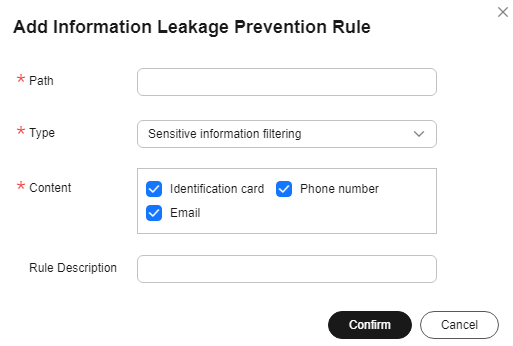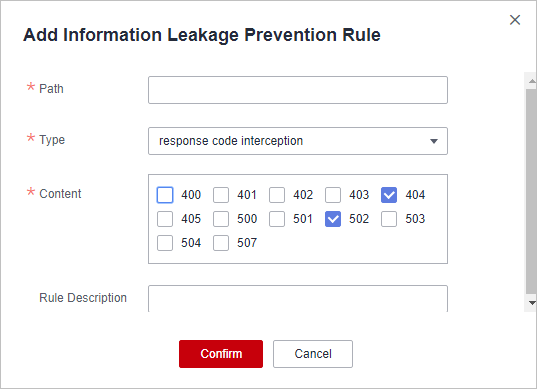Configuring Information Leakage Prevention Rules to Protect Sensitive Information from Leakage
You can add two types of information leakage prevention rules.
- Sensitive information filtering: prevents disclosure of sensitive information, such as ID numbers, phone numbers, and email addresses.
- Response code interception: blocks the specified HTTP status codes.
Prerequisites
You have added the website you want to protect to WAF or added a new protection policy.
Constraints
- It takes several minutes for a new rule to take effect. After the rule takes effect, protection events triggered by the rule will be displayed on the Events page.
Configuring an Information Leakage Prevention Rule
- Log in to the management console.
- Click
 in the upper left corner of the management console and select a region or project.
in the upper left corner of the management console and select a region or project. - Click
 in the upper left corner of the page and choose .
in the upper left corner of the page and choose . - In the navigation pane on the left, click Policies.
- Click the name of the target policy to go to the protection configuration page.
- In the Information Leakage Prevention configuration area, change Status if needed and click Customize Rule.
Figure 1 Information Leakage Prevention configuration area

- In the upper left corner above the Information Leakage Prevention rule list, click Add Rule.
- In the dialog box displayed, add an information leakage prevention rule by referring to Table 1. Figure 2 and Figure 3 show the examples.
Information leakage prevention rules prevent sensitive information (such as ID numbers, phone numbers, and email addresses) from being disclosed. This type of rule can also block specified HTTP status codes.
Sensitive information filtering: Configure rules to mask sensitive information, such as phone numbers and ID numbers, from web pages. For example, you can set the following protection rules to mask sensitive information, such as ID numbers, phone numbers, and email addresses:Response code interception: An error page of a specific HTTP response code may contain sensitive information. You can configure rules to block such error pages to prevent such information from being leaked out. For example, you can set the following rule to block error pages of specified HTTP response codes 404, 502, and 503. - Click Confirm. The added information leakage prevention rule is displayed in the list of information leakage prevention rules.
Related Operations
- To disable a rule, click Disable in the Operation column of the rule. The default Rule Status is Enabled.
- To modify a rule, click Modify in the row containing the rule.
- To delete a rule, click Delete in the row containing the rule.
Feedback
Was this page helpful?
Provide feedbackThank you very much for your feedback. We will continue working to improve the documentation.See the reply and handling status in My Cloud VOC.
For any further questions, feel free to contact us through the chatbot.
Chatbot







